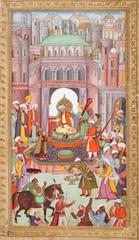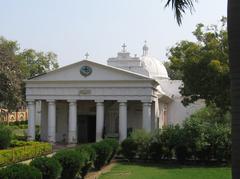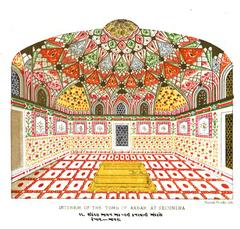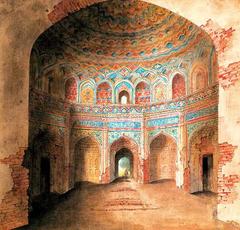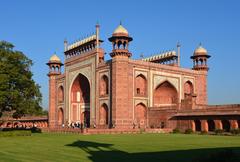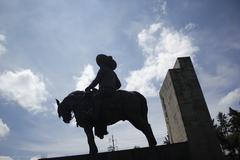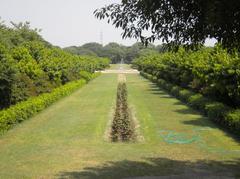Jama Masjid Agra: Visiting Hours, Tickets, and Historical Sites Guide
Date: 14/06/2025
Introduction
Jama Masjid in Agra stands as an enduring symbol of Mughal architectural excellence and spiritual legacy. Commissioned in the mid-17th century by Jahanara Begum, daughter of Emperor Shah Jahan, this mosque is a vibrant center of religious and cultural life for the city. Its prime location opposite Agra Fort and near the bustling Kinari Bazaar places it at the heart of Agra’s historic landscape, closely linked to other architectural marvels such as the Taj Mahal (godigit.com; japjitravel.com; TripXL).
Constructed with red sandstone and white marble, adorned by elegant Persian calligraphy and intricate floral motifs, Jama Masjid serves both as an active mosque and as a living museum of Mughal artistry. It accommodates thousands of worshippers, especially during Friday prayers and major Islamic festivals, while welcoming visitors from across the globe (agratourpackages.com; tripoto.com).
This guide provides a comprehensive overview of Jama Masjid’s historical origins, architectural features, and essential visitor information—covering opening hours, ticketing, accessibility, nearby attractions, etiquette, and travel tips—to ensure a respectful and enriching visit (Tour My India; Uttar Pradesh Tourism).
Historical Background
Origins and Patronage
Commissioned in 1643 CE and completed in 1648, Jama Masjid was built under the patronage of Jahanara Begum, a prominent Mughal princess and daughter of Shah Jahan and Mumtaz Mahal. Her personal involvement and financial contribution highlight the vital role of royal women in Mughal public works (godigit.com; japjitravel.com). The mosque’s name, “Jama,” denotes its purpose as a grand congregational mosque, central to the city’s Islamic community.
Construction and Location
The mosque was constructed over five years by a skilled workforce of around 5,000 artisans and craftsmen, at a cost of approximately Rs. 5 lakhs—a significant investment at the time (trawell.in). Initially intended to be built on the banks of the Yamuna, the site was shifted to avoid obstructing the Taj Mahal’s view and to better serve the city’s civic and religious needs (japjitravel.com).
Historical Events and Modifications
Jama Masjid originally faced Tripolia Chowk, a major commercial plaza that was demolished in the 19th century for the construction of Agra Fort Railway Station, altering the mosque’s urban context. The mosque also sustained structural damage during the Indian Rebellion of 1857, particularly to its eastern portico (trawell.in).
Spiritual and Cultural Significance
For over three centuries, Jama Masjid has served as a spiritual hub for Agra’s Muslim community, hosting Friday congregational prayers, Eid celebrations, and other religious events. The presence of tombs linked to the Sufi Christi family further enhances its spiritual significance (godigit.com).
Architectural Brilliance
Design Features
Jama Masjid is a striking example of Mughal architecture, combining red sandstone and white marble with intricate black stone calligraphy and geometric inlays (TripXL). The mosque sits on a high plinth, accessed by 35 broad steps, and features a large rectangular courtyard with a central ablution fountain.
Facade and Domes
The eastern entrance is the most prominent, adorned with Persian inscriptions praising Shah Jahan and Jahanara Begum. The prayer hall comprises five arched bays, crowned by three domes with alternating red and white marble bands in a zigzag pattern. The domes are topped with lotus-shaped finials—a hallmark of Mughal design (omastrology.com).
Decorative Elements
The mosque’s walls and ceilings display painted floral motifs and Persian calligraphy, while the main prayer compartment faces Mecca, featuring a beautifully carved marble mihrab and pulpit (tripoto.com). Chhatris (domed kiosks) and slender minarets enhance the structure’s symmetry and grandeur.
Urban Integration and Legacy
Nestled amid Agra’s historic bazaars, Jama Masjid forms a cohesive part of the city’s urban heritage. Its proximity to Agra Fort and the Taj Mahal makes it a vital stop for anyone exploring Mughal-era sites (agratourpackages.com). Continuous preservation efforts help maintain its architectural integrity (placeapp.in).
Visitor Information
Opening Hours
- Daily: 6:00 AM – 6:00 PM
- Peak Times: Fridays and Islamic festivals (expect larger crowds)
Tickets & Entry
- Entry Fee: Free for all visitors. Donations are welcome for mosque upkeep.
- Guided Tours: Available through local guides for a fee. Arrangements can be made at the entrance or through tour operators.
Accessibility
- Wheelchair Access: Partial, with ramps at main entrances. Some areas may be less accessible due to steps and uneven surfaces.
- Mobility Tips: Assistance is recommended for visitors with limited mobility.
Dress Code & Etiquette
- Clothing: Modest attire required; shoulders and knees should be covered. Women may need to cover their heads.
- Footwear: Shoes must be removed before entering the prayer hall.
- Photography: Allowed in the courtyard; restricted in the prayer chamber—always seek permission.
- Conduct: Maintain silence and respect during prayer times.
Facilities
- Restrooms: Available near the entrance, though basic.
- Water: Filtered drinking water provided; carrying bottled water is advisable.
- Shops: Numerous vendors offer snacks and local souvenirs outside the mosque.
- Guides: Available in multiple languages for deeper insights into history and architecture.
Travel Tips & Best Practices
- Combine Visits: Plan your visit with nearby sites: Agra Fort (500 meters away), Taj Mahal (2.5 km), and Kinari Bazaar (walking distance).
- Best Time: October to March for pleasant weather; early mornings and late afternoons for the best photography and fewer crowds.
- Transport: Easily accessible by auto-rickshaw, taxi, or on foot from city center or railway stations.
Accessibility & Safety
- Security: Standard screenings at entrances; avoid carrying large bags or restricted items.
- Health: Carry sun protection and stay hydrated, particularly in summer. Adhere to health advisories when applicable.
- Assistance: Mosque staff and guides are generally helpful; arrange for any special needs in advance.
Frequently Asked Questions (FAQ)
Q1: What are the visiting hours?
A1: Daily from 6:00 AM to 6:00 PM.
Q2: Is there an entry fee?
A2: No, entry is free for all visitors.
Q3: Are guided tours available?
A3: Yes, local guides offer tours for a fee.
Q4: Is the mosque wheelchair accessible?
A4: There is partial accessibility with ramps at entrances, but some areas may require assistance.
Q5: Can non-Muslims visit Jama Masjid?
A5: Yes, non-Muslims are welcome but should avoid the main prayer hall during prayers and dress respectfully.
Q6: Is photography allowed?
A6: Yes, in the courtyard; restricted in the prayer hall—always seek permission.
Nearby Attractions
- Agra Fort: UNESCO World Heritage Site, directly across from Jama Masjid (UNESCO Agra Fort).
- Taj Mahal: Iconic mausoleum, 2.5 km from the mosque.
- Kinari Bazaar: Bustling market for handicrafts, textiles, and street food.
- Other Sites: Numerous Mughal-era monuments and gardens within Agra.
Cultural Insights and Community Life
Jama Masjid is not just a monument but a living center of faith and culture. It hosts major Islamic festivals, religious classes, and charitable events, reflecting Agra’s diverse and inclusive heritage. The mosque’s continued use for worship alongside its recognition as a heritage site exemplifies the harmonious coexistence of tradition and modernity (TripXL).
Final Tips for Visiting Jama Masjid Agra
- Plan Ahead: Check for special events or festivals that might affect visiting hours.
- Dress Modestly: Respect the religious sanctity and local customs.
- Stay Hydrated: Carry water, especially during warmer months.
- Engage a Guide: Deepen your appreciation of the mosque’s history and architecture.
- Combine Destinations: Visit Agra Fort and Kinari Bazaar for a full experience of Agra’s rich heritage.
Further Reading and Official Resources
- Jama Masjid in Agra – GoDigit
- Jama Masjid Agra – Japji Travel
- Jama Masjid Agra Overview – Trawell
- Jama Masjid Agra Guide – Agratourpackages
- Jama Masjid Agra Tourist Information – Tripoto
- Jama Masjid Agra Historical and Cultural Significance – TripXL
- Jama Masjid Agra Visitor Information – Tour My India
- Uttar Pradesh Tourism Official Website
- Agra District Administration
- Agra Tourism Information – Agratourism
For interactive maps, virtual tours, and more travel inspiration, download the Audiala app and follow us on social media!
